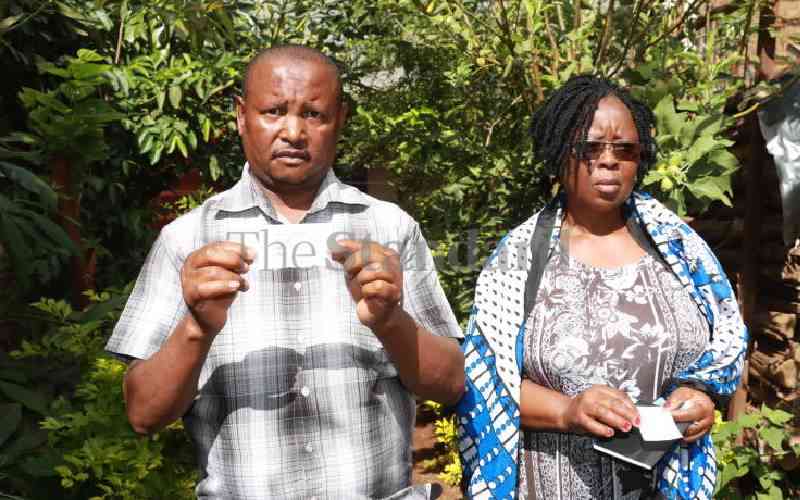It is easily an ignored part of dairy cow management. Yet, hoof trimming determines about 20 per cent of production levels.
This is critical at a time when the dairy sector in Kenya is on the rise as more small and mid-sized farmers take into dairy farming.
Zero grazing comes with a major but ignored challenge — damage to hooves.
The overgrown hooves are responsible for lameness and limping in most cows.
They also cause foot rot among other infections likely to hamper milk production and attract high costs in curative mechanisms.
The lameness and attendant pain could also affect reproduction and fertility. In some farms it leads to culling yet the cow could still be productive.
SNV Netherlands Development Organisation through Kenya Market-led Dairy Programme (KMDP) and Dejirine LTD, a Eldoret-based dairy service provider are sensitising farmers and professionals on hoof care.
Recently, the team held a two-day workshop at Risa Farm, Red Hill in Limuru for field demos and training on hoof trimming.
Holland based expert, Alex De Jong was at hand to show the farmers how trimming is done.
“If you don’t trim the hooves, they become large and therefore affect production which dips to about 20 per cent,” De Jong explained.
Experts advise that hooves or claws that are longer than three inches should be sliced off.
This has to be perpendicular to the sole. It’s a delicate process that requires care not to remove a huge chunk of the claw that would eventually hurt the cow.
Cosmas Muchina, the SNV Monitoring & Evaluation expert under the KMDP noted that maximum care should be accorded to dairy cows for optimal output. “We are building the capacity of farmers and professionals in a modernisation effort that will enable their herd to be commercially viable and their services to improve respectively,” he said.
He added: “KMDP supports innovation and adoption of new dairy technologies to meet the increasing demand for the today’s farmer. It does this through demos and farm visits like this one in Limuru to empower farmers and entrepreneurs who want to take the challenge of driving the dairy sector in the grassroots.”
Stay informed. Subscribe to our newsletter
Trimming creates balance on the cow by making the hooves to their standard shape.
This is critical to support the cow’s weight. It also helps to drain off muck and slurry around a lesion. It removes puss that could be as a result of diseases and therefore discourages development of swellings.
“We didn’t know much about hoof trimming,” said Rachael Wambui, a trainee from Nyeri.
“Now we have learnt a lot. We’re going to empower other farmers. We now know the importance of hoof trimming,” she said.
Hoof trimming is a bit tough, rough and delicate – hence the need for training.
The cow has to be physically contained in a cage then it is tied to reduced movement, and then its leg is raised using a special machine.
The trimmer carefully uses sharp hoof knives to slice off the excess layers. At times a grinder is needed too to flatten the hoof evenly. If the hoof has developed a wound, it has to be treated, bandaged and a shoe placed with glue to allow for ample healing.
“We strongly advise that the trimming should be done at least three times in a year,” De Jong noted.
In Kenya, this practice has not picked up but it is expected to rise with more awareness. The same training was replicated in Uasin Gishu County.
“Our hope is that some farmers will emerge as experts and therefore will be able to offer trimming services to their neighbors at a fee. This will therefore open new business opportunities for them,” said Dejong.
Here are important factors to consider when doing hoof care:
Location - Consider indoors vs outdoors, access to power plugs and work space, including room to move freely and space for tools. Also take into consideration the lighting.
Ensure cows will move in and out of the trimming area safely and that the traffic will flow smoothly.
Ask your cattle hoof trimming professional if the set up is working or if something needs to be changed.
Cattle Sorting and Collection - Have your cows sorted ahead of time and a group waiting prior to cattle hoof trimming.
Having the cattle ready will get the trimmer in and out more quickly and reduces downtime.
Keep things as normal as possible for the cows. Don’t have too big of a group where the animals are standing without food and water for hours on end.
Assistance - Always have enough assistance so that the trimmer never has to step away from the trimming area.Schedule enough staff to help sort, group and move cattle back and forth, so the cattle hoof trimming professional can get right to work.
— Additional info from Internet sources
 The Standard Group Plc is a
multi-media organization with investments in media platforms spanning newspaper
print operations, television, radio broadcasting, digital and online services. The
Standard Group is recognized as a leading multi-media house in Kenya with a key
influence in matters of national and international interest.
The Standard Group Plc is a
multi-media organization with investments in media platforms spanning newspaper
print operations, television, radio broadcasting, digital and online services. The
Standard Group is recognized as a leading multi-media house in Kenya with a key
influence in matters of national and international interest.
 The Standard Group Plc is a
multi-media organization with investments in media platforms spanning newspaper
print operations, television, radio broadcasting, digital and online services. The
Standard Group is recognized as a leading multi-media house in Kenya with a key
influence in matters of national and international interest.
The Standard Group Plc is a
multi-media organization with investments in media platforms spanning newspaper
print operations, television, radio broadcasting, digital and online services. The
Standard Group is recognized as a leading multi-media house in Kenya with a key
influence in matters of national and international interest.







